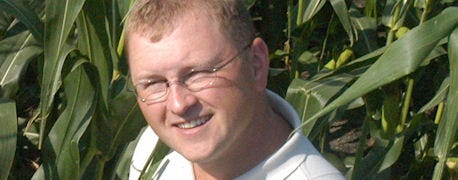March 9, 2014

This might be the year to "go back to basics" when trying to maximize corn profits, says Adam Spelhaug, agronomist, Peterson Farms Seed, Harwood, N.D.
"In recent years, we've had the opportunity to try some inputs or practices that may not have been possible in tighter times. Some of these inputs may have worked, but I'm guessing many yielded inconsistent results. That is the problem with many non-traditional products; while you'll usually get a response, it will rarely be consistent. Too often we try to add 2-5 bushels per acre with these products, but neglect some of the basics of crop production that can help maximize profit: planting accuracy and fertilizer rates and timing," he says.

Adam Spelhaug, agronomist with Peterson Farms Seed, Harwood, N.D., plans to focus more on on precision planting and fertilizing.
Spelhaug's basics include:
•Planting accuracy. "Calibrating and properly setting up your planter will dramatically increase your seeding accuracy, producing higher and more uniform stand counts. My trial work shows a 10bu increase in corn yield simply by reducing planting speeds. Slowing down while planting leads to better stands as well as emergence of all plants within the same time. I have also gained 5 bushels per acre by keeping planting depths under 2-inches and have gained almost 60 bushels per acre when reducing shallow planting. Even if you utilized all available soil amendments and growth promoters, you would not gain back the bushels lost in the spring during planting," he says.
Every decision that you make influences the size and scope for corn yields. From the corn hybrid you select to the seeding rate and row width you choose. Download our FREE report over Maximizing Your Corn Yield.
•Fertilizer rates and timing. "We've heard a lot of buzz about variable rate technology this winter," he says. "Lower overall fertilizer costs this year, and placing the fertilizer only where it is needed, provides opportunities to increase profit by reducing input costs," he says. As a result of the late fall, less fertilizer was applied last season, so it will need to be applied this spring or in-season. "There is heightened interest in side-dressing this year. Anhydrous ammonia and liquid are great forms of nitrogen for the plant. They both have pros and cons (safety, costs, handling, etc.). The benefit of liquid is the ability to add other nutrients (mostly Sulfur) that the plant may need at that time. Many nutrient deficiencies were incorrectly diagnosed last spring as N when sulfur was actually lacking in the plant. We will be working with blended N & S products at differing rates this summer," he says.
Peterson says if you can improve planting accuracy, fertilizer rates and fertilizer timing you can add much more than the 2-5 bushels per acre that non-traditional products can provide.
Read more of Peterson's advice in his column in the Dakota Farmer magazine.
You May Also Like




